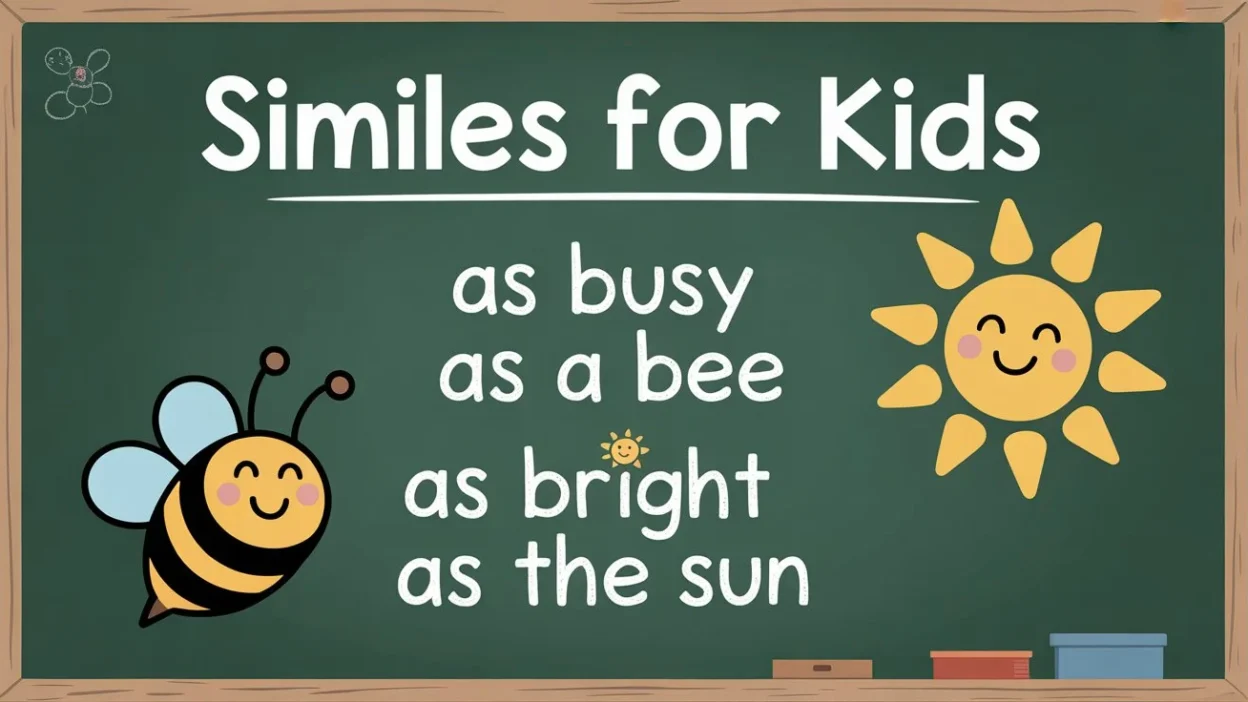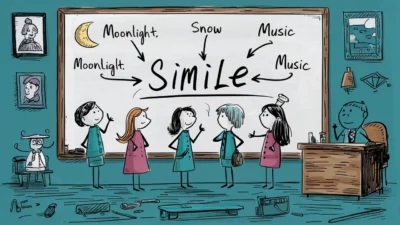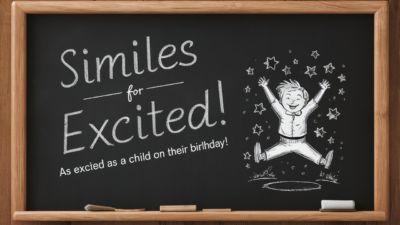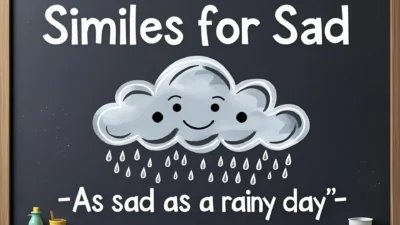Understanding language through creativity is one of the best ways for children to learn. Similes, which compare two different things using “like” or “as,” are powerful tools that not only make language more vivid but also enhance kids’ cognitive abilities.
When children learn similes, they improve their descriptive writing, develop imagination, and begin to grasp abstract thinking—all key to academic and social success.
In this article, you’ll discover 35+ similes perfect for young learners, each with a clear and memorable example. We’ll also explore how similes vary depending on tone (funny, polite, serious), setting (school, home, creative writing), and emotional intention.
Whether you’re a teacher, parent, or curious learner, this guide is your ultimate resource for teaching and mastering similes in 2025 and beyond.
🧠 What Is a Simile?
A simile is a figure of speech that directly compares two different things using the words “like” or “as.” The purpose is to create a mental image or connection that helps the listener or reader better understand or visualize something.
For example:
- Her smile was as bright as the sun.
In this sentence, the brightness of her smile is being compared to the sun, creating a vivid picture in the reader’s mind.
🎯 Why Should Kids Learn Similes?
In 2025, educational frameworks are increasingly focused on creative literacy—the ability to not just read and write, but to express and interpret creatively. Similes are a cornerstone of this framework. Here’s why:
- 🧠 Boosts imagination: Encourages children to think metaphorically.
- 🗣️ Improves communication: Helps kids explain feelings or thoughts in relatable ways.
- ✍️ Enhances writing skills: Adds flair and depth to storytelling.
- 📚 Improves comprehension: Assists with understanding literature and poetry.
🧒 Similes for Kids: 35+ Best Examples
Here are some fresh and child-friendly similes that are fun, relatable, and educational. Each is followed by a simple example sentence to show it in use.
1. As Brave as a Lion
Example: Jack was as brave as a lion when he stood up during show-and-tell.
2. As Quiet as a Mouse
Example: She was as quiet as a mouse when she tiptoed through the library.
3. As Busy as a Bee
Example: Alex was as busy as a bee finishing his science project.
4. As Light as a Feather
Example: The kitten was as light as a feather in her arms.
5. As Happy as a Clam
Example: After winning the race, Jamie was as happy as a clam.
6. As Fast as Lightning
Example: Mia ran across the field as fast as lightning.
7. As Cool as a Cucumber
Example: Even during the spelling bee, he stayed as cool as a cucumber.
8. As Sweet as Honey
Example: Grandma’s voice was as sweet as honey.
9. As Sharp as a Tack
Example: Sam is as sharp as a tack when it comes to solving puzzles.
10. As Bright as the Sun
Example: Her yellow dress was as bright as the sun.
✨ Fresh Similes for 2025: Newly Inspired Ideas for Kids
These similes are brand new for 2025, developed with a focus on digital-age imagery, mindfulness, and playfulness—great for today’s learners.
11. As Bubbly as Soda Pop
Example: Her laugh was as bubbly as soda pop on a hot summer day.
12. As Playful as a Puppy
Example: The kids were as playful as puppies at recess.
13. As Smart as a Robot
Example: Leo solved the math puzzle like he was as smart as a robot!
14. As Quiet as a Screenshot
Example: He was as quiet as a screenshot during the surprise party.
15. As Clear as a Touchscreen
Example: Her explanation was as clear as a touchscreen on full brightness.
16. As Zoomy as a Drone
Example: The paper plane flew as zoomy as a drone.
17. As Sticky as Bubble Gum
Example: The spilled juice was as sticky as bubble gum on a shoe.
18. As Bright as a Pixel
Example: Her idea was as bright as a pixel in the dark.
19. As Still as a Loading Bar
Example: He stood as still as a loading bar stuck at 99%.
20. As Loud as a Notification Ping
Example: His hiccup was as loud as a notification ping during class.
🎭 Tone in Similes: Polite, Funny, and Professional Variants
Similes can take different tones depending on who you’re speaking to and why. Let’s break it down.
🧸 Similes in Casual or Funny Tone
These work well in conversations with friends or creative storytelling.
- “As silly as a dancing giraffe.”
- “As clumsy as a penguin in roller skates.”
🧑🏫 Similes in Professional or Academic Tone
Ideal for formal writing or classroom settings.
- “As meticulous as a scientist during an experiment.”
- “As articulate as a news anchor.”
🧍♀️ Similes in Polite Tone
Used when you want to be respectful or gentle.
- “As thoughtful as a handwritten card.”
- “As kind as a sunny morning.”
🔍 How to Use Similes Effectively in Writing and Speech
To master similes, children should learn how and when to use them. Here’s a breakdown:
✅ Do:
- Use similes to describe emotions:
“He was as nervous as a leaf in the wind.” - Use them to describe actions vividly:
“She danced like a snowflake falling from the sky.” - Use them sparingly to avoid cluttering the text.
🚫 Don’t:
- Use a simile just to sound fancy—it must add meaning.
- Mix metaphors or similes that confuse the image:
“He was as cold as a fire.” (That’s contradictory.)
🌈 10 Creative Similes for Different Situations
These 10 hand-crafted examples illustrate how context changes the tone of a simile.
1. As fast as a race car
- Context: Sports Day
- Tone: Energetic, fun
2. As colorful as a rainbow cake
- Context: Birthday party
- Tone: Playful
3. As tall as a giant giraffe
- Context: Describing a teacher
- Tone: Friendly exaggeration
4. As silent as a closed book
- Context: Reading time
- Tone: Calm, respectful
5. As excited as popcorn in a microwave
- Context: Waiting for a holiday
- Tone: Humorous, casual
6. As caring as a teddy bear hug
- Context: Thank-you note
- Tone: Polite, warm
7. As tricky as a maze
- Context: Solving a riddle
- Tone: Engaging, fun
8. As wobbly as jelly on a trampoline
- Context: Learning to roller-skate
- Tone: Silly
9. As glowing as a firefly at night
- Context: Complimenting a child
- Tone: Gentle, kind
10. As magical as a storybook ending
- Context: Bedtime story
- Tone: Whimsical, dreamy
💡 Teaching Similes: Tips for Educators and Parents
🧩 Activities That Work
- Simile Journals: Ask kids to write one simile a day about their feelings or observations.
- Art + Language: Have them draw what the simile describes.
- Guess That Simile: Play a game where one person starts a simile and others guess the ending.
📲 2025 Tech Tip:
Use voice-assisted apps that encourage kids to create similes with real-time feedback, powered by child-safe AI interfaces available on many tablets.
📝 Simile Practice Prompts for Kids
Here are 5 imaginative writing prompts to inspire young writers:
- Describe your favorite food using a simile.
- Write about your best friend using two similes.
- Create a simile to describe a storm.
- Make a silly simile about a dancing animal.
- Use a simile to explain how you feel before a test.
🔚 Conclusion: The Power of Similes for Young Minds
Similes are not just literary tools—they are windows into imagination. By learning how to use similes, kids can communicate with color, humor, emotion, and clarity.
Whether writing a story, expressing feelings, or simply having fun with words, similes make language come alive.
So encourage your child or student to think metaphorically, play with words, and enjoy the creative ride.
In 2025, where digital literacy and emotional expression are more important than ever, teaching similes is one of the most effective steps toward building brilliant communicators.




